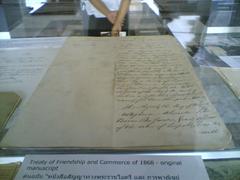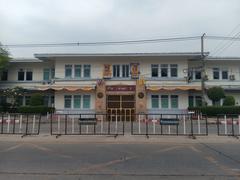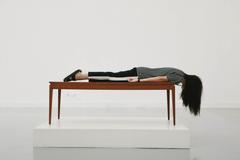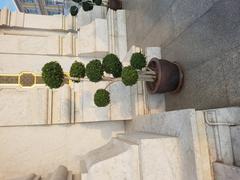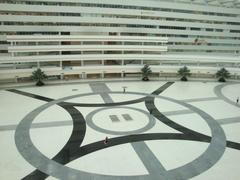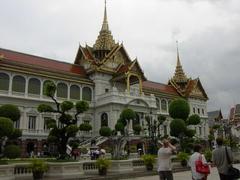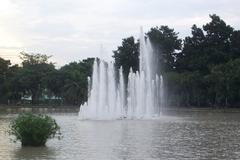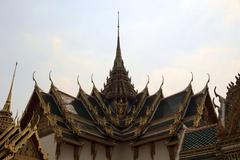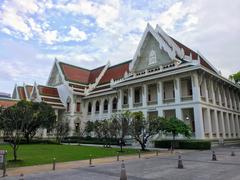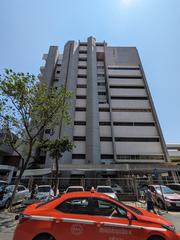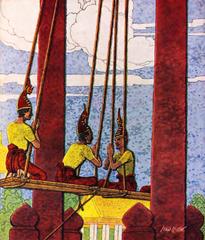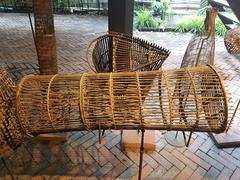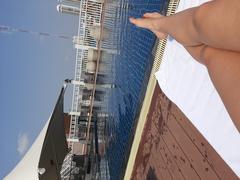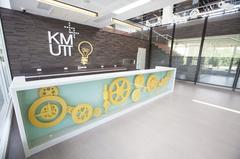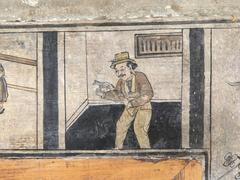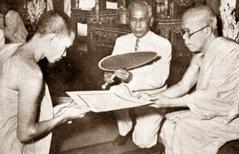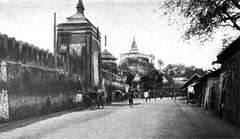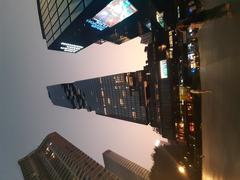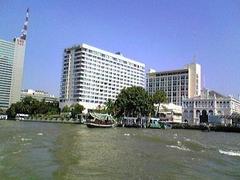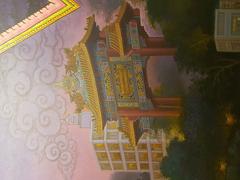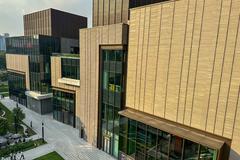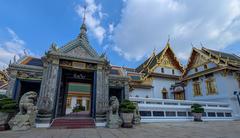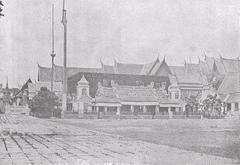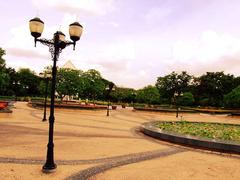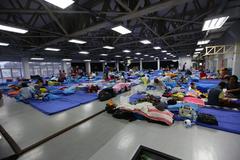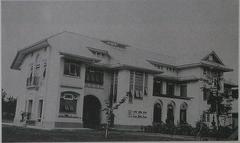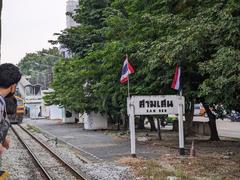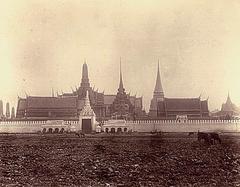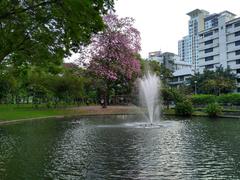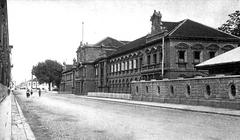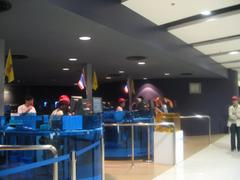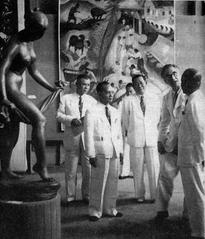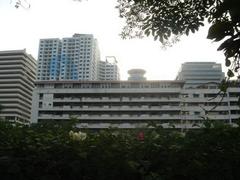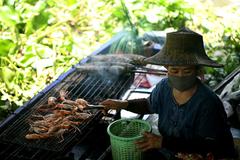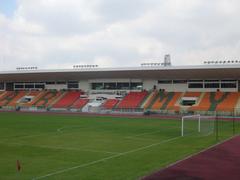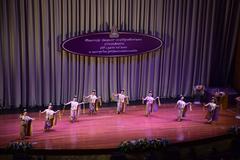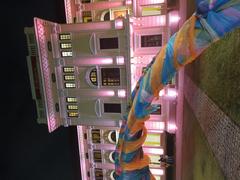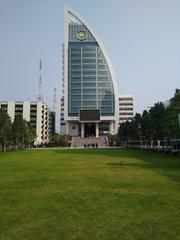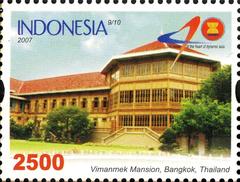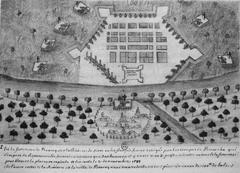
Abhisek Dusit Throne Hall: Visiting Hours, Tickets, and Historical Insights in Bangkok
Date: 04/07/2025
Introduction to Abhisek Dusit Throne Hall
Abhisek Dusit Throne Hall, gracefully set within the verdant grounds of Bangkok’s Dusit Palace complex, is a striking emblem of Thailand’s royal heritage and architectural innovation. Commissioned by King Chulalongkorn (Rama V) and completed in 1904, the hall masterfully unites Moorish, Victorian, and traditional Thai design elements, embodying the era’s spirit of modernization and cultural fusion. Initially a royal audience chamber and ceremonial venue, the hall now welcomes visitors as the Thai Handicraft Museum—showcasing the nation’s artistry and community empowerment initiatives. This guide provides comprehensive details on Abhisek Dusit Throne Hall’s historical significance, architectural features, visiting hours, ticket information, accessibility, and travel tips for an enriching experience (Tourism Authority of Thailand, SUPPORT Foundation, Bangkok Post).
Table of Contents
- Historical Background and Architectural Significance
- Transformation into the Thai Handicraft Museum
- Visiting Information: Hours, Tickets, and Accessibility
- Key Exhibitions and Collections
- Nearby Attractions and Travel Advice
- Visitor Tips and Frequently Asked Questions (FAQ)
- Plan Your Visit and Stay Connected
- Sources and Further Reading
Historical Background and Architectural Significance
Royal Vision and Construction
Commissioned by King Chulalongkorn (Rama V) as part of his modernization drive, the Abhisek Dusit Throne Hall was constructed from 1903 to 1904. Italian architect Mario Tamagno designed the hall to serve as both a reception chamber for foreign dignitaries and a venue for state banquets and parliamentary gatherings. Its innovative design reflects the king’s desire to harmonize Western influences with traditional Thai aesthetics.
Architectural Highlights
The single-storey rectangular hall is renowned for:
- Victorian “Gingerbread” Woodwork: Intricate fretwork and floral-patterned motifs along the facades and verandas.
- Moorish Porticoes and Arches: Creating a sense of openness and grandeur, while adapting to Bangkok’s tropical climate.
- Stained Glass Windows and Stucco Details: Enhancing the interplay of natural light and color.
- Traditional Thai Decorative Motifs: Mythological carvings and lattice panels celebrate Thai spiritual and royal heritage.
This harmonious blend of styles marks the hall as an architectural marvel and a symbol of cultural exchange during a pivotal period in Thai history.
Transformation into the Thai Handicraft Museum
Following its royal functions, the hall was repurposed as a museum under the patronage of Queen Sirikit. Today, it operates as the Thai Handicraft Museum, curated in collaboration with the SUPPORT Foundation. The museum celebrates regional craftsmanship, supports rural artisans (especially women), and preserves Thailand’s intangible cultural heritage through dynamic exhibitions and live demonstrations (SUPPORT Foundation).
Visiting Information: Hours, Tickets, and Accessibility
Opening Hours:
- Tuesday to Sunday: 9:00 AM – 4:00 PM
- Closed on Mondays and public holidays.
Tickets:
- International visitors: 100 THB
- Thai nationals and residents: Free admission
- Discounts available for students and seniors
- Tickets are available at the entrance or online via the official Dusit Palace website.
Location:
- Dusit Palace Complex, Ratchawithi Rd, Dusit, Bangkok 10300, Thailand
Accessibility:
- Wheelchair-accessible entrances and pathways
- Assistance available for visitors with mobility needs
- Clean restrooms and refreshment stands on-site
Dress Code:
- Modest attire required: long pants or skirts, sleeved shirts, and closed shoes
- Clothing rentals are available for those needing appropriate attire
Photography:
- Permitted in most areas (no flash or tripods); some special exhibits may restrict photography
Getting There:
- BTS Skytrain (Victory Monument or Saphan Khwai stations), followed by a short taxi or tuk-tuk ride
- Accessible by city bus or river taxi to the Dusit district
Key Exhibitions and Collections
Thai Handicrafts:
Experience masterful displays of handwoven silk, delicate lacquerware, nielloware, silverwork, and wood carvings—many crafted by rural artisans under the SUPPORT Foundation’s initiatives.
Royal Memorabilia:
Explore historical photographs, official documents, ceremonial regalia, and gifts that chronicle the legacy of King Rama V and the Chakri dynasty.
Rotating Exhibitions:
Regular temporary exhibitions highlight Thai culture, royal traditions, or contemporary crafts, often coinciding with national celebrations or cultural festivals.
Notable Rooms:
The main hall retains its original throne and regal interiors, while side chambers feature thematic displays of regional artistry and royal history.
Nearby Attractions and Travel Advice
Within Dusit Palace Grounds:
- Vimanmek Mansion: The world’s largest golden teakwood building (check current opening status)
- Ananta Samakhom Throne Hall: A grand Italian Renaissance-style edifice, now a museum
- Amphorn Sathan Residential Hall: The current royal residence (external viewing only)
Travel Tips:
- Arrive early to enjoy the gardens and avoid crowds
- Stay hydrated and wear sun protection due to Bangkok’s hot, humid climate
- Guided tours are offered in English and Thai—booking ahead is recommended for groups
Visitor Tips and Frequently Asked Questions (FAQ)
Q: What are the Abhisek Dusit Throne Hall visiting hours?
A: Open Tuesday to Sunday, 9:00 AM to 4:00 PM; closed Mondays and public holidays.
Q: What is the ticket price?
A: Admission is 100 THB for international visitors; free for Thai nationals and residents. Discounts apply for students and seniors.
Q: Is the hall wheelchair accessible?
A: Yes, with ramps and smooth walkways throughout the complex.
Q: Can I take photographs inside?
A: Photography is allowed in most areas without flash or tripods; certain exhibits may restrict photos.
Q: Are guided tours available?
A: Yes, in English and Thai; inquire at the entrance or book online.
Q: How do I get to the hall via public transport?
A: Take the BTS Skytrain to Victory Monument or Saphan Khwai, then a short taxi or tuk-tuk ride.
Q: What is the dress code?
A: Modest attire covering shoulders and knees is required; rentals are available at the entrance.
Plan Your Visit and Stay Connected
Make the most of your Bangkok journey by exploring the Abhisek Dusit Throne Hall—a living testament to royal vision, cultural preservation, and community empowerment. For up-to-date information on visiting hours, exhibitions, and special events, consult official sources and consider downloading the Audiala app for guided audio tours and exclusive content. Explore related articles on Thai royal palaces, handicrafts, and Bangkok historical sites, and follow us on social media for travel inspiration and updates.
Sources and Further Reading
- Tourism Authority of Thailand – Abhisek Dusit Throne Hall
- SUPPORT Foundation
- Bangkok Post – Dusit Palace

